|

As Persian and Chinese traders in silks and spices; their colourful caravans laden with cinnamon and cloves,
ginger and tamarind; came westward, they also trafficked in ideas and inventions.
Gradually the sight of windmills became commonplace in the Mediterranean and Europe.
In Spain, along the route of The Black Villages and beside the Way of Saffron Fields and Castles, they stood
like citadels.
Dependable monuments to industry, the means of keeping families fed, they were as important to the body as the
church which owned them was to the soul.
Here, where golden star thistle and the purple sea lavender give fragrance to the hot, dry atmosphere, the sails
still turn, cleaving the air like Moorish scimitars.
Throughout Spain and the Canary Islands the mills are tourist attractions, preserved and enhanced to serve as
living museums, or to house exhibitions, displays or even tourists themselves.
The windmills of La Mancha are high, cylindrical towers of dazzling white capped with black cones.
From a distance they look like portly nuns on their way to mass. The conical tops have over the years been fashioned from
a variety of materials: straw, wood and now zinc.
In Cervante's time, the vanes would have been made from Black Poplar, a wood which does not shrink,
warp or swell. Internal machinery was oak, lubricated with tallow, the whole held together by expert carpentry and rivets
of pine.
Both tower mills and the open wooden trestle mills were used for grinding grains, though the Spanish
language distinguishes between the two, the tower mills are molinos, and the trestle and modern wind-farm mills, molinas
or molinetas.

Los molinos de viento de España
never provided a living space as in some European windmills. There was an area where grain would be bagged and loaded
and perhaps a small space beneath to stable mules. Then the next level housed the millstones and the upper floors the machinery
and a gallery for the storage of linen vane cloths and other essentials, the whole accessed by a spiral staircase.
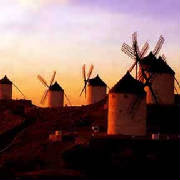
At intervals around the tower were windows, set not for the pleasure of looking out over the lush Iberian
landscape, but for alerting the miller to a change in winds.
It was imperative that he knew the very instant the wind changed so he could move the tiller beam (or tailpole)
to turn the mill. Failure to do this, especially if the wind strengthened could, and often did, result in the total destruction
of the building.
Should the vanes move too rapidly, friction sparks from the stones could ignite the flour and there are many
stories of sudden gales which, catching an inattentive miller unawares, stripped the tower of the sails, cone and part of
the building itself, often with loss of life, always with loss of livelihood.
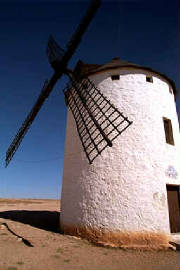
From the 13th Century, 3rd March has been Llueca's Day, a month when comets flew and people would gather
at the mill to pay homage, bringing food to share. Each villager would be given a hollow bun in celebration of the miracle
of harvest and the mill's part in it.
There was in fact, another miracle taking place. The word 'mill' means, 'to go round' and until mechanisation, grain was
processed manually and traditionally by women. When milling was harnessed to the winds, a huge cultural turn was also brought
about , for then the task began to revolve around men.
Perhaps those simple villagers were more spiritual than we are today. They had built by hand the imposing towers which
ground to infinitesimal dust that grain the Deity had provided and matured to sustain their bodies.
Standing beneath the vast edifice with its sails turning and creaking against the heavens, they must have felt they had
harnessed the very breath of God.
Llueca's Day is still celebrated around the windmills, now a family festival
of kites and food.
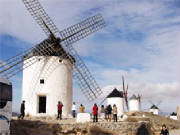
Every Spanish mill was given a name. In the northeast province of Ciudad Real some thirty mills sit on the Hill
of La Paz. The Sardinero contains some original, 17th century machinery; The Culebro
and The Lizard house museums (the latter dedicated to farming) The Pylon preserves the history
of wine; The Burleta and Infant also have original machinery, the latter still grinding
grain so that visitors may observe the operation of a working mill. The Poyatos serves as the Office of Tourism.

At San Pedro del Pinatar Saltworks Nature Reserve,
a unique Mediterranean coastal area of 700 hectares, there are dunes, salt marshes, reed beds and wild sandy beaches. But
also encañizadas the traditional fishing system of Mar Menor.
Fish are forced to pass across a complex labyrinth built of reeds and wood
whence they are captured - the water is pumped through this system by windmill.

But lately there has been another revolution in the world of windmills,
the winds of change are blowing across the Iberian mountains and Spain is rapidly turning to the modern, electricity-generating
mills as source of clean power. This has caused criticism in some quarters.
From a local news report:
The decision to allow the construction of 11 new wind parks and 400 windmills
at Campillos, Cañete la Real, Teba, Almargen and Casares has angered ecologist groups. The Andalucían Federation of Associations
for the Defence of Nature (FAADN) is outraged and points out that the wind-power generators would stand on a vital route for
endangered species of eagles, vultures and other raptors.
A five-year study undertaken by Agaden-Ecologistas en Acción in Tarifa, where
there is a large concentration of wind-power generators, has already documented 81 Leonardo Vultures killed as a result of
collisions or other incidents involving the windmills. The study also catalogued deaths of eagles, owls and other species
that, along with the vultures, are protected under a European Union directive.
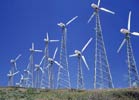
In Tarifa, the well-established wind park generates some 1500 kW of power for approximately 300,000 inhabitants.
They may be vital to the economy, they may be powerful and awesome as they march across the landscape but wind turbines
have none of the romance Cervantes saw when his Don Quixote tilted at the great windmills of Spain.
Should you wish to purchase a Spanish windmill, the tower variety, converted for living,
sells for around a million British pounds.
Slightly cheaper and pre-packed in wooden crates for sending to the four winds, the Tarrago
windmills are a popular and colourful sight on Spanish cattle ranches where they pump water and produce electricity. No doubt with
a little ingenuity, they could also catch fish.
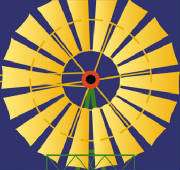
|
| The sunny face of a kit-set windmill |
|

